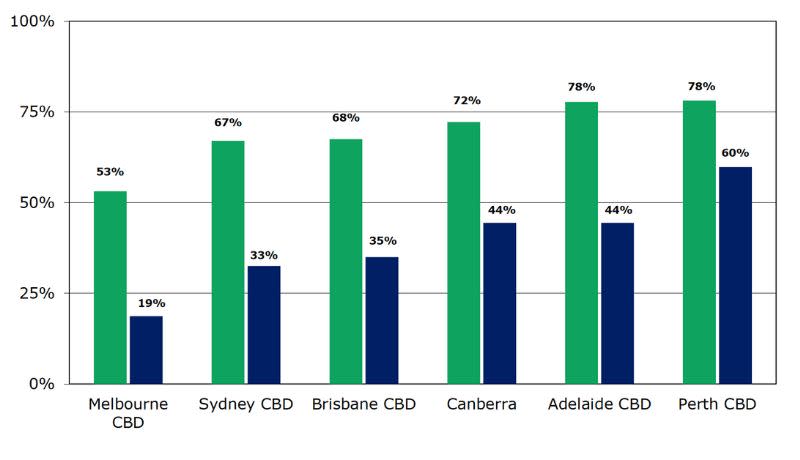A wave of infections from the Omicron variant caused office occupancy rates across most major cities to go backwards in July, according to the Property Council of Australia.
The council’s latest office occupancy survey found Omicron, together with influenza infections, had pushed Melbourne’s occupancy rate down from 49 to 38 per cent. Sydney went from 55 to 52 per cent, Brisbane from 64 to 53 per cent and Adelaide from 71 to 64 per cent.
Only Canberra and Perth weathered the winter surge in infections to record increases in office occupancy, from 53 to 61 per cent and 65 to 71 per cent, respectively.
Property Council chief executive Ken Morrison said the results were disappointing but unsurprising due to the rise in case numbers.
“Office occupancy numbers have gone backwards for the first time in six months as a wave of omicron and flu cases kept workers away from the office,” Morrison said.
“We have been seeing a steady increase in the number of workers returning to offices, but this stalled in June and has now declined in most capitals, which is disappointing but unsurprising.
The winter weather was always going to be a roadblock to a wholescale return to city centres and office work.
Last month the Property Council pointed to a number of disruptions causing the sudden slow-down of back-to-office momentum, including severe wet weather and a rise in Covid and influenza cases.
Morrison said the council was encouraged that the Omicron wave appeared to have peaked and winter weather would soon pass. He hoped it meant the recovery momentum could resume.
He said the low levels of CBD occupancy needed to be factored in when governments were considering measures to manage the pandemic.
“We know office occupancy has been slow to recover, unlike other indicators which snap back quickly,” Morrison said.
Daytime peaks and lows in office occupancy, July
“The losers are not the office tenants or the owners of office buildings, it’s all those retailers, cafes and restaurants who rely on office workers as their customers.
“We want those businesses and their jobs to survive because they give our CBDs such vibrancy.
“Governments and health authorities need to remember that asking people to work from home is not a zero-cost exercise – the costs are real, and we see them in the vibrancy of our CBDs.”
But last week the industry was told there were other factors at play when getting staff to return to the office in a post-pandemic world.
Construction giant Lendlease released data showing newer and younger workers did not want to go back to the office, and in some cases, did not want to engage at all.
In part, those findings were in keeping with the council’s survey that says the preference for greater flexibility, including working from home, was a major driver of occupancy levels. Those figures have sunk from 63 to 48 per cent.
Despite the effects of the pandemic and a drop in occupancy, the council says businesses have leased more space across the country’s CBDs over the past six months, with demand increasing by a 0.5 per cent.
Health concerns surrounding the latest wave also proved to be a major influence on the data, rising from 17 per cent in June to 30 per cent in July.
Morrison said with peak infections period waning it was critical that governments communicate clearly with business and not send mixed signals regarding working from home.
The survey was conducted in the field from July 25 to August 1.










